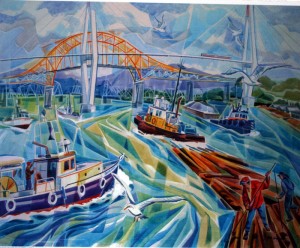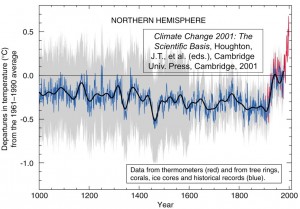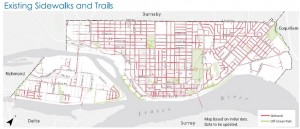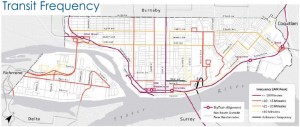Please excuse me while I engage in some meta-blogging.
Things around here are going to change a bit. I have been blogging as “GreenNewWest” for almost two years now, but I actually started blogging before that as a way to keep in touch with friends and family back home while travelling, something I continue to do at T’N’PotR .
Clearly, I didn’t put a lot of thinking into where this blog was going, or about the actual process of blogging, when I got into GreenNewWest. The choice of Blogger was make quickly, as it was free and easy. I didn’t want to waste time learning new software or interfaces, I just wanted to write. The same detailed consideration was taken in choosing the Blogs name. I literally went into Blogger, decided that no-one was going to read “Pat Johnstone.blogspot”, and that good names like “google” had already been taken.
My initial intent of this blog was to talk about New Westminster, politics, and the environment from a scientific viewpoint. This made sense as, at the time, I was fully immersed in the New Westminster Environmental Partners, I was getting into my new job as an Environmental Coordinator, and I was becoming more involved in local politics. To define my politics at the time into a simple category, “Green” seemed to fit the best, and “GreenNewWest.blogspot” was available. Design a banner and Bob’s Yer Uncle.
In hindsight, If I knew I was going to do this for more than a few months or weeks, or that anyone other than my Mom might read this, I might have put more thought into those initial steps, but I didn’t, so here we are. Hearing my blog name mentioned during a City Council meeting by someone who was clearly neither me nor my Mom, got me thinking: If I’m going to keep doing this thing, I gotta make it mine, no borrowed labels. Therefore a name change is in order.
Why change? Part of the problem is that “Green” is one of those words that acts like baggage: makes life easier at first, people can figure out where your niche is. Eventually any niche just slows you down. The word “green” is so loaded with preconceptions and alleged linkages, that it seems to define the viewpoint before it is expressed. I didn’t vote for the Green Party last election (although I do think Elizabeth May is doing an excellent job in Ottawa, and is punching well above her weight hitting issues that the other opposition parties are missing, mostly as they stare inwards during their respective leadership races). If you mention “Green” to anyone who doesn’t immediately make the Green Party or Greenpeace association, they will think either of money (if they are over 40), or pot (if they re under 40).
Forthe record, I quit smoking pot years ago, and all my money is tied up in a mortgage on a 70-year-old house (its kinda small, a little sketchy, and pretty old, but I can almost afford it…)
I also want this blog to continue to explore parts of my life here in New Westminster that are not necessarily “Green”. Even for an environmental scientist, environmental coordinator, and environmentalist like me, putting a Green spin on every story gets tiresome. Sometimes, I just want to talk about my back yard.
“NIMBY” is a term commonly used to describe many environmental arguments, an acronym for “Not In My Back Yard”.
Like scare tactics based on complex conspiracy theories and logical fallacies, the NIMBY approach to environmental issues is one I try strenuously to avoid. Some local issues such as the United Boulevard Extension and the burning of Metro Vancouver trash can easily fall into NIMBYism, but I have always tried to make it clear that what is good for my gander is good for others’ geese. Moving the Metro Vancouver incinerator to Crofton does not end my opposition to the idea of burning trash for profit. It is precisely other municipalities’ successes with limiting the growth of automobiledom that encouraged us to say no to UBE, and in the end, I wanted to see the UBE money spent on real, sustainable transportation improvements (like Evergreen, or Rails for the Valley) even if they are not in New Westminster. I am a lot of things, many of them irrational, but a Nimby I’m not.
Ultimately, New Westminster is my back yard, but so is BC, from the Gulf Islands where my In-laws live to the Kootenays where my Parents live – I spend a lot of time in both places. And I like to travel to futerher off areas. I also recognize that everything I do in my literal back yard – that 1,500 square feet where my compost and my green cone and my fig tree and my carport are – impacts the City, the Province, the Country and the World, just as the rest of the world impacts my back yard. This is why we “act locally and think globally”.
So, as of now, GreenNewWest is no more. Bring on NWimby.blogspot.com , because New Westminster Is My Back Yard. (I’m thinking the “W” can be silent in acronymic conversation.)
Clearly, I am no internet whizz, so hopefully, if you go to GreenNewWest it will prompt you to come here instead. I moved all of the GNW archive over here, so you can still scroll through and search the horror of my past, but of course links and such probably get screwed up, and your links will probably need updating. Maybe a year from now, if I’m still here, that won’t be such a problem, but until then, thanks off the patience, and update your links.












